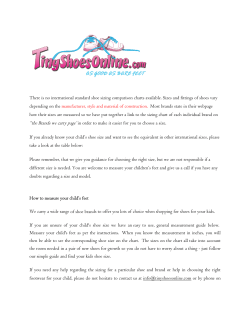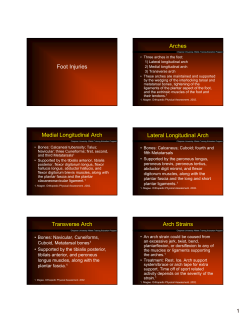
It is reputed that the ... the forefoot. approximately one half the body’s
ICB Medical 4/17-19 Marshall Rd Kirrawee NSW 2232 T: +61 2 9545 4769 F:+61 2 9545 5567 E: info@icbmedical.com Superior Biomechanics Newsletter Issue 15 Treating Sesamoiditis with Orthotic Therapy By Abbie Najjarine BSc (Pod) - QMU UK Dip Pod - NSW Sesamoiditis is not a particularly common condition and can be difficult to diagnose and treat. Sesamoiditis is painful inflammation of the sesamoid apparatus, which is located in the forefoot under the 1st MTPJ. Sesamoiditis is characterised by pain at the first metatarsal sesamoid commonly occurring in combination with a plantar flexed 1st metatarsal. This condition may present as often as in 4% of overuse type foot injuries (Dennis and McKinney, 1990). Sesamoiditis typically affects physically active young people and in my experience is more common in sporting people who require balance on the ball of the foot (such as ballet dancers, basketballer, netballer, cricket players and soccer players) - as they attempt to stop and change direction by pivoting or putting pressure on the forefoot area and specifically the ball of the 1st MTPJ. Sesamoiditis causes pain in the ball of the foot under the 1st MTPJ and commonly affects the medial (inner) side. The pain may be constant, or it may occur with or be aggravated by, movement of the big toe joint. It may also be accompanied by swelling (edema) throughout the plantar aspect (bottom) of the forefoot. It is reputed that the forefoot bears approximately one half the body’s weight and balances pressure on the ball of the foot. The hallux (big toe) has two phalanges and two joints (interphalangeal joints), together with two small sesamoid bones (the medial and lateral sesamoid bones). The sesamoids are implanted or embedded in the flexor hallucis brevis tendon which exerts pressure from the big toe against the ground and aids in the act of walking during the toe-off phase of gait. The sesamoids not only have to endure the pressure of body weight and gravity, but also the constrictive pressure of the flexor hallucis brevis tendon . Sesamoids Figure 1: Plantar aspect. It is generally accepted that the sesamoids perform two principal functions: 1. Absorbing impact forces in the forefoot during walking through a series of attachments to other structures in the forefoot. 2. Acting as a fulcrum to provide the flexor tendons with a mechanical advantage as they pull the hallux down against the ground during gait. Patients who suffer from Sesamoiditis often exhibit a fixed or mobile plantar flexed 1st metatarsal which maintains the 1st MTPJ in a plantarflexed position on impact. The lesser metatarsals are able to absorb the impact in the gait cycle, however, the 1st MTPJ is rigid and the sesamoid take the full impact during toe off. Repetitive chronic pressure and tension on the forefoot will cause the surrounding tissues to become irritated and inflamed. In some cases the sesamoids may bifurcate and in severe cases necrosis may occur. The practitioner should always check the patient for a Plantarflexed 1st using the common test in which the movement of the joint should be 5mm dorsiflexion, and 5mm plantar flexion or a total range of approx 10mm. This test will identify if there is a limitation in the joint’s range of motion due to a fixed osseous condition. To perform this test: 1. With the patient in the supine position, maintain the foot in the neutral position, 2. Grip the lesser metatarsals, line the thumbs up and the range of movement should be 5mm up and 5mm down. Due to pronation the sesamoids displace laterally causing trauma to the sesamoid apparatus. This can change the patient’s gait as they try to compensate and may cause other upper body compensatory effects, including hip pain. Treatment Initial treatment for sesamoiditis is usually non-invasive and includes orthotic therapy to treat the plantarflexed 1st. Generally a deflection will need to be incorporated into the orthotic to remove or reduce the pressure from this area. The Plantarflexed 1st Ray deflection is cut around the 1st MTPJ and then the edges are heated and smoothed to taper the edge of the orthotic, and avoid irritation (see Figure 2). The orthotic itself has in-built forefoot support under the 2nd to 5th and supports this area similar to a 2-5 bar. Modifying the patients’ shoes is not overly effective as each pair would need to be modified. The easier approach is a heat mouldable orthotic incorporating a Plantarflexed 1st ray deflection modification which can be moved and transferred from shoe to shoe with relative ease. In addition, the big toe may be bound with strapping tape (or athletic strapping) to immobilize the joint as much as possible and allow healing to take place. Acupuncture can be used to reduce inflammation and anti inflammatory drugs can be taken to reduce swelling. REFERENCES Michaud T.C. (1993) Foot Orthoses and Other Forms of Conservative Foot Care. Williams and Wilkins, Baltimore, pp.93-105. Root M.L., Orien W.P. and Weed J.H., (1971) Clinical Biomechanics: Normal and Abnormal Function of the Foot. Clinical Biomechanics Corp, Los Angeles, Chapter 10. Figure 2: Plantarflexed 1st Ray Deflection created in orthotic. www.icbmedical.com
© Copyright 2025





















